Many gardeners’ top priority is planting upright plants with vibrant flowers that attract attention from miles away. But this is where they miss another big aspect of creating a beautiful landscape for their garden.
For instance, the moment you set foot in your garden, your eyes and subconscious mind will automatically notice something that is missing in between those plants. And this is where ground cover plants come in.
Growing ground cover plants will instantly make your garden look fuller, greener, and aesthetically richer than just planting tall and upright plants.
In fact, there are certain species of ground covers that can produce flowers and add more colors to your landscape. That being said, let’s take a look at fifteen of them.
Table of Contents
1. Ice Plant (Delosperma cooperi)

Ice plants are herbaceous, groundcover plants that are indigenous to Africa. These plants grow 3 to 6 inches tall and spread 12 to 24 inches wide.
What makes ice plants interesting is that this species is drought tolerant. Hence, they are equipped to live in arid or hot regions.
You can recognize these spreading perennials by their daisy-like flowers that come in assorted colors such as purple, blue, yellow, orange, red, and pink.
They also have green succulent leaves that will turn darker during the fall.
Ice plants usually bloom in summer, spring, and fall. They thrive in hardiness zones 6 to 10 and perform best when grown under full sun.
2. Chamomile (Chamaemelum nobile)

Chamomiles are no strangers to avid tea drinkers and medicinal herbs practitioners. These plants are native to Western Europe. There are two most popular varieties of chamomile, which are Roman and German chamomiles.
You can recognize these plants by their fragrant, daisy-like white-and-yellow flowers.
On average, chamomiles grow 8 to 24 inches tall and spread 8 to 12 inches wide. They grow best in hardiness zones 4 to 9.
These drought-tolerant plants also perform well under full sun and in moist, well-drained soils. You can expect chamomiles to bloom prolifically in the summer and fall.
3. Pachysandra (Pachysandra terminalis)
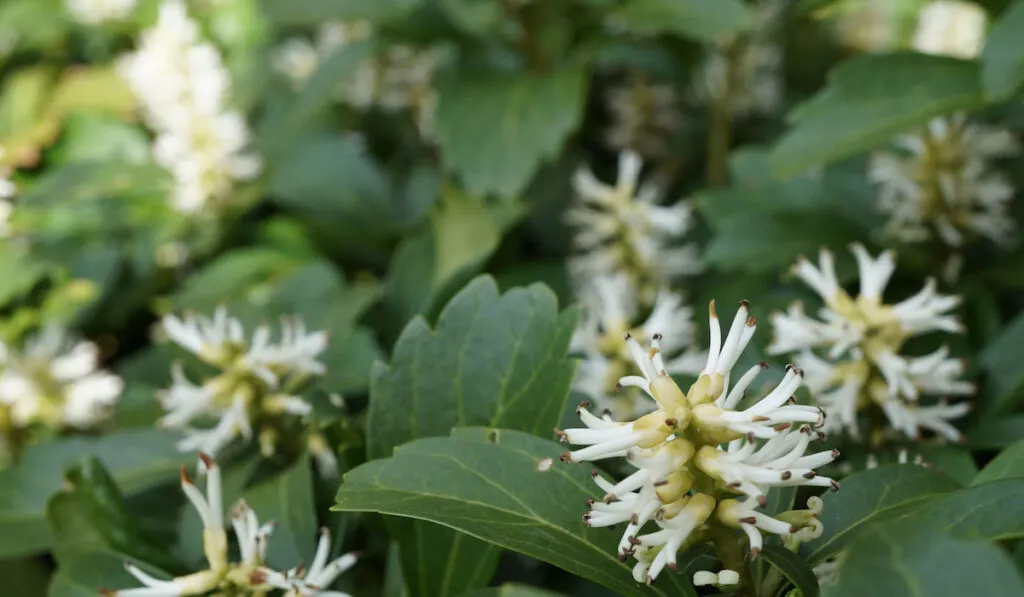
Also known as Japanese spurges, these herbaceous plants are indigenous to Asia, particularly Japan and China. These plants can grow up to 1 foot tall and spread horizontally up to 1.5 feet.
Pachysandras are low-growing plants with dark green, oval-shaped foliage and small white flowers that appear in the spring.
Like most perennials, pachysandras can tolerate partial or full sun and prefer to grow in moist and slightly acidic soil. Overexposure to the scorching sun can turn their leaves yellow. So, the best spot to grow them would be under partial to full shade. These plants thrive in hardiness zones 5 to 9.
4. Canada Anemone (Anemone canadensis)

Canada anemones can provide thick and luscious groundcovers for your landscape. They are also called meadow anemones, roundleaf anemones, and American meadow anemones.
These perennials have beautiful, five-petaled white flowers that attract insect pollinators such as butterflies.
On average, Canada anemones grow 12 to 24 inches tall and spread 9 to 35 inches wide. They perform well in hardiness zones 3 to 8.
Growing Canada anemones is fairly simple. They can tolerate partial or full sun, and moist, well-drained soil.
These plants will bloom prolifically in the summer and spring. As they spread mostly by underground rhizomes, you can expect Canada anemones to fill the ground quickly in just a short period of time.
5. Creeping Phlox (Phlox subulata)
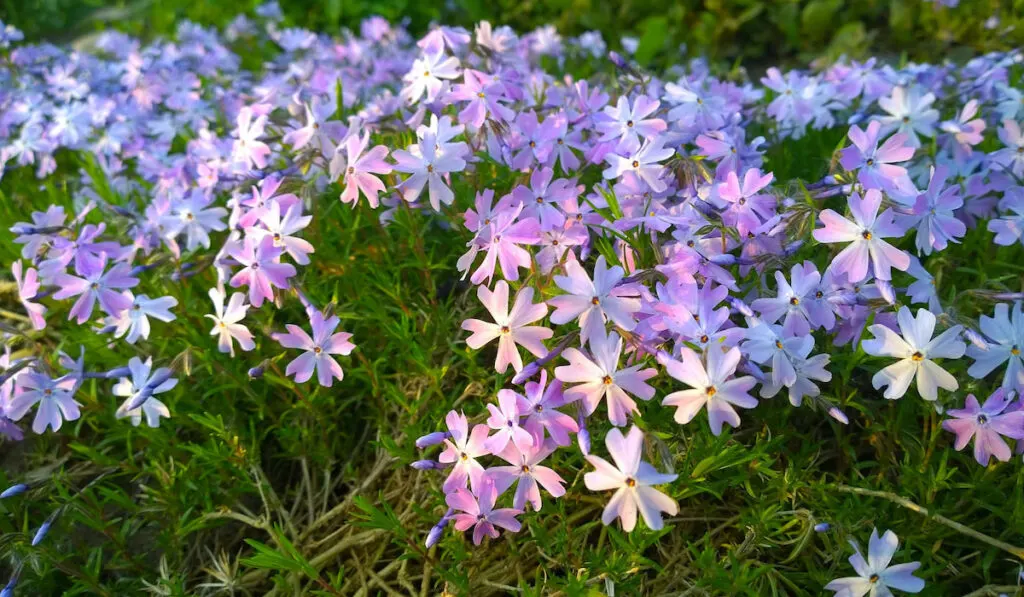
Creeping phloxes are native to the central and eastern United States. They are also known as moss phlox or mountain phlox. There are a few varieties of creeping phloxes such as ‘Candy Stripe,’ ‘Snow Flake,’ and ‘Blue Emerald.’
Each variety of the creeping phlox produces different flowers that come in white, lavender, pink, purple, or pink and white.
Creeping phloxes thrive in hardiness zones 3 to 9. They grow 4 to 6 inches tall and spread 1 to 2 feet wide. This is also how they received their name, due to being low-growing plants that resemble thick carpets or moss.
Creeping phloxes love full sun and grow best in moist and well-drained soil. They are easy to maintain and resistant to high salinity and deer grazing.
6. Candytuft (Iberis sempervirens)
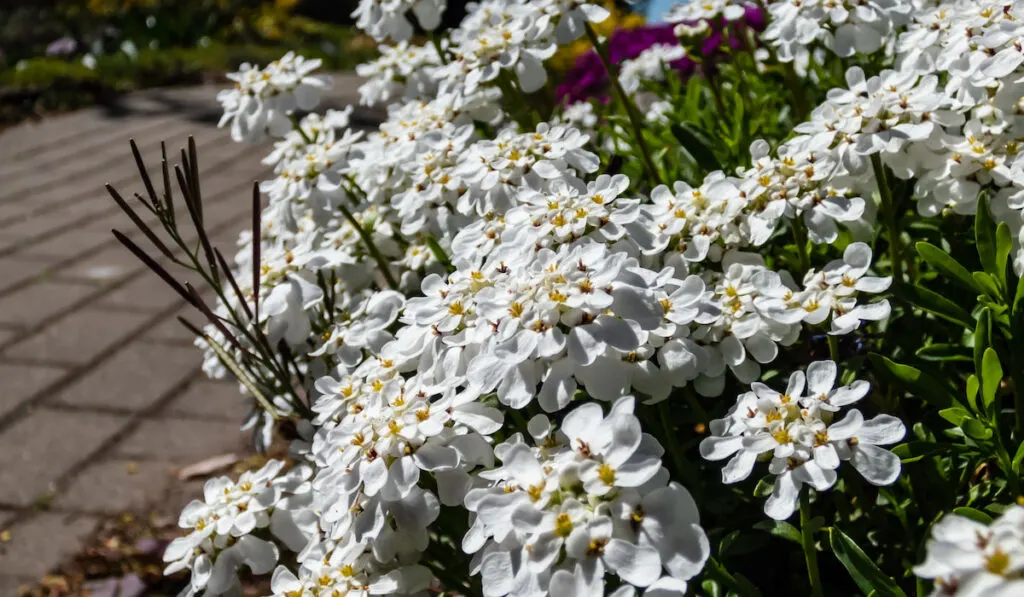
Candytufts are indigenous to Europe and the Mediterranean.
These herbaceous perennials produce beautiful, lush flowers that come in white, red, pink, and lilac. You can also recognize them by their small, oblong-shaped, dark green foliage.
On average, candytufts grow 12 to 18 inches and spread up to 16 inches. They can tolerate partial or full sun. However, the best medium to grow these plants is in moist and alkaline soil that has good drainage.
Candytufts usually bloom in the spring. During this period, you can deadhead or prune old leaves to promote better growth and keep these plants fresh. They thrive in hardiness zones 3 to 9.
7. Dragon’s Blood Sedum (Sedum spurium ‘Dragon’s Blood‘)
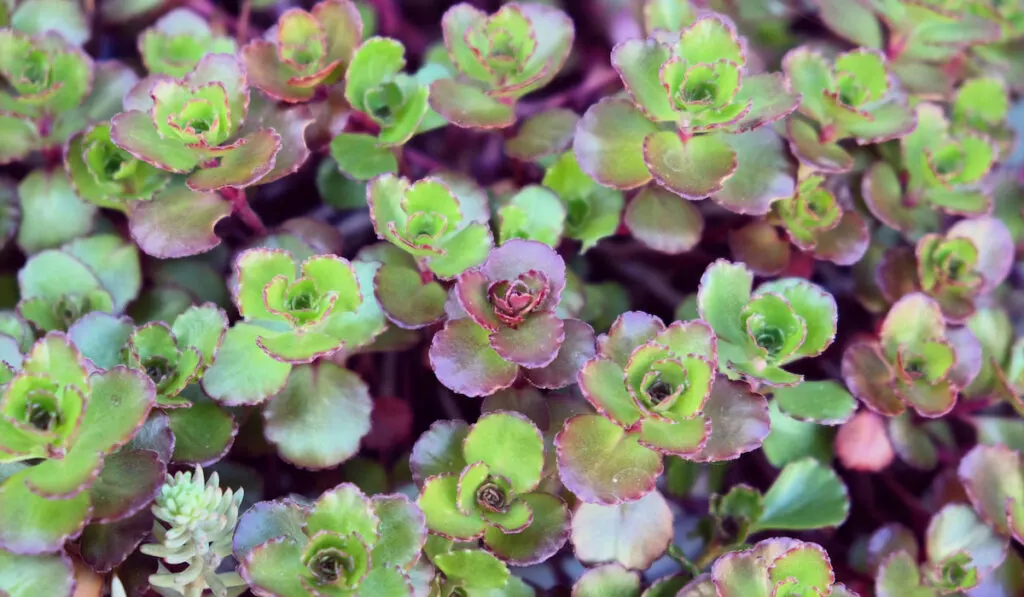
Although their name sounds intimidating, these plants are actually beautiful when you plant them as groundcovers.
Dragon’s Blood sedums or Caucasian stonecrop plants are native to the Caucasus, located near the Black Sea and the Caspian Sea. These plants grow 4 to 6 inches tall and spread across 12 to 18 inches.
Dragon’s Blood sedums have bronze-red, star-shaped flowers and green foliage.
These flowers start blooming in the summer and turn bright red when fall comes. These plants grow well in hardiness zones 4 to 9.
Growing Dragon’s Blood sedums is quite simple. They need enough exposure to full sun, and moist but well-drained soil. However, if there’s a change in temperature, drainage, and moisture level, these hardy plants are able to tolerate and adapt quickly.
8. Sweet Woodruff (Galium odoratum)
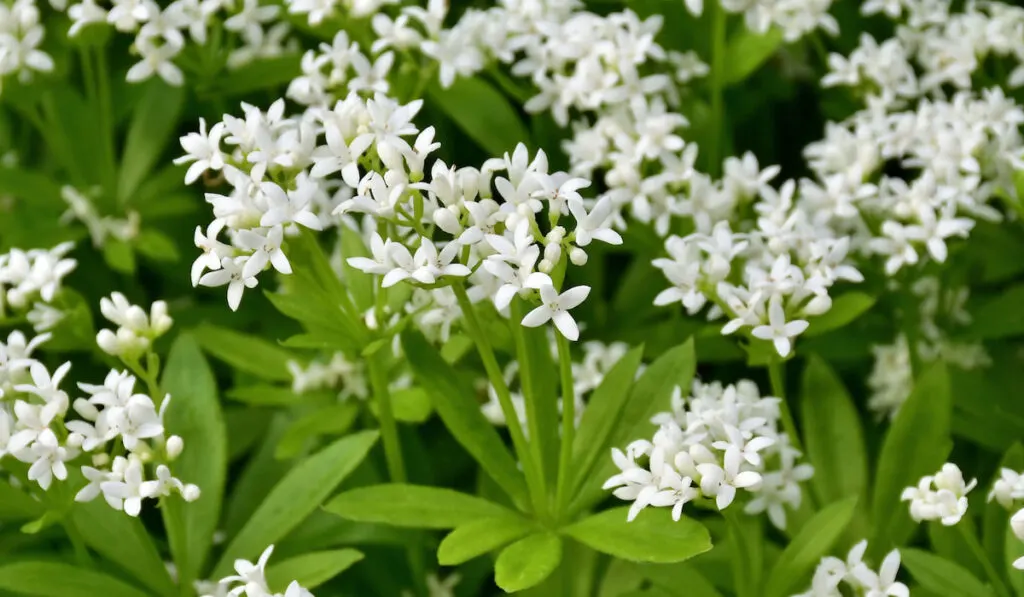
Sweet woodruff is native to Europe, Asia, and Africa.
You can spot these perennials by their green lance-shaped leaves and star-shaped white flowers that bloom in the spring.
On average, sweet woodruff grows 6 to 12 inches tall and spreads 9 to 18 inches. They also thrive in hardiness zones 4 to 9.
When planting sweet woodruff, the best spot to grow these plants is under shade or in places with tall trees. As long as they grow with enough moisture in slightly acidic soil, sweet woodruff is easy to maintain.
However, if you live in an arid and hot region, these plants don’t do well, especially if they receive daily exposure to the hot scorching sun. They can also go dormant when the temperature during the summer is too high.
9. Creeping Thyme (Thymus serpyllum)

Creeping thymes are also called wild thymes, woolly thymes, Breckland thymes, and mother of thymes. They are indigenous to Europe, Asia, and Africa.
These plants grow well in hardiness zones 4 to 9 and grow extensively to form thick, mat-like colonies on the ground. They only grow 2 to 3 inches tall but can spread horizontally up to 1 foot wide.
You can recognize creeping thymes by their clusters of small purple flowers that bloom in the summer.
These flowers produce a citrus fragrance that attracts pollinators such as bees and butterflies. They also have aromatic bluish-green leaves that turn to bronze when fall comes.
Creeping thymes perform well under full sun. The best medium to plant this hardy species in is an alkaline, well-drained soil.
10. Wild Violet (Viola sororia)

Wild violets or meadow violets are native to North America and Europe. Out in the wild, they grow in different habitats such as lakes, meadows, riverbanks, creeks, and areas with water sources.
These plants have five-petaled, purplish-blue or white flowers that bloom in early spring. They also possess palmate-veined green leaves that come in kidney or heart shapes.
On average, wild violets grow 4 to 6 inches tall with the same spread. They thrive in hardiness zones 3 to 7. These plants prefer moist and well-drained soil. You can either grow them under partial or full sun.
Overall, wild violets are easy to maintain. They are mostly resistant to pests and deer attacks.
11. Creeping Dogwood (Cornus canadensis)
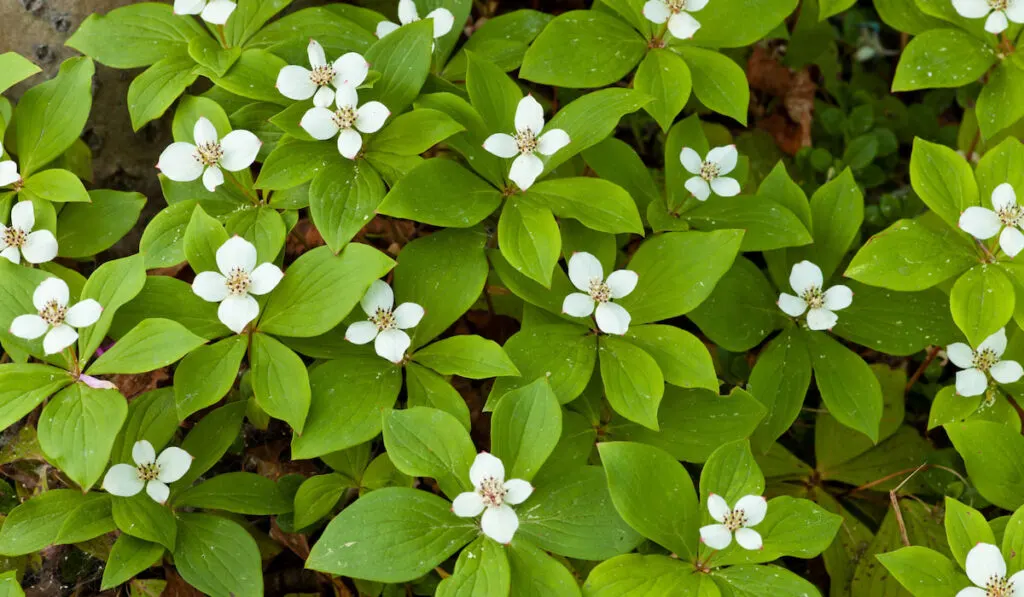
These herbaceous plants are native to North America. They are also known as bunchberry, ground dogwood, dwarf dogwood, and Canadian dwarf cornel. Creeping dogwoods grow 6 to 12 inches spread up to 30 inches wide.
You can spot these plants by their small, greenish-white flowers and oval-shaped green foliage. Their leaves will also turn maroon or dark red in the fall.
Creeping dogwoods grow well in hardiness zones 2 to 7. They prefer partial sun or areas with enough shade and acidic, moist, and well-drained soil. When fall comes, these plants produce small red berries. They repel deer and attract insect pollinators such as butterflies.
With enough moisture, shade, and nutrients in the soil, creeping dogwoods are easy to maintain.
12. Lithodora (Lithodora diffusa)

Lithodoras are beautiful groundcovers that bloom from spring until summer. These plants are native to Europe. They are also called purple gromwell ‘Grace Ward’ and gromwell ‘Grace Ward’. They grow well in hardiness zones 6 to 8.
Lithodoras have vibrant star-shaped blue flowers and dark green lance-shaped foliage.
On average, Lithodoras grow 6 inches to 1 foot tall and spread 2 to 3 feet wide. They prefer full sun but are able to tolerate partial or shaded areas. These plants also love slightly acidic and well-drained soil with enough moisture.
Lithodoras are low-maintenance plants that are resistant to pest and deer attacks. You should also prune these plants occasionally to promote better growth of their flowers.
13. Sweet Alyssum (Lobularia maritima)

These European native plants grow invasively in the United States, particularly in California. These flowers bloom prolifically in the spring and fall.
Sweet Alyssum possesses grayish-green lance-shaped leaves and clusters of small flowers that come in diverse colors such as white, purple, yellow, and pink.
They grow 3 to 10 inches tall and spread 2 to 4 inches wide. They thrive in hardiness zones 5 to 9 and can tolerate partial or full sun. As long as there is enough moisture, these plants can tolerate any type of soil. To promote fresh flowers, you can trim and cut old flowers regularly.
14. Creeping Mazus (Mazus reptans)
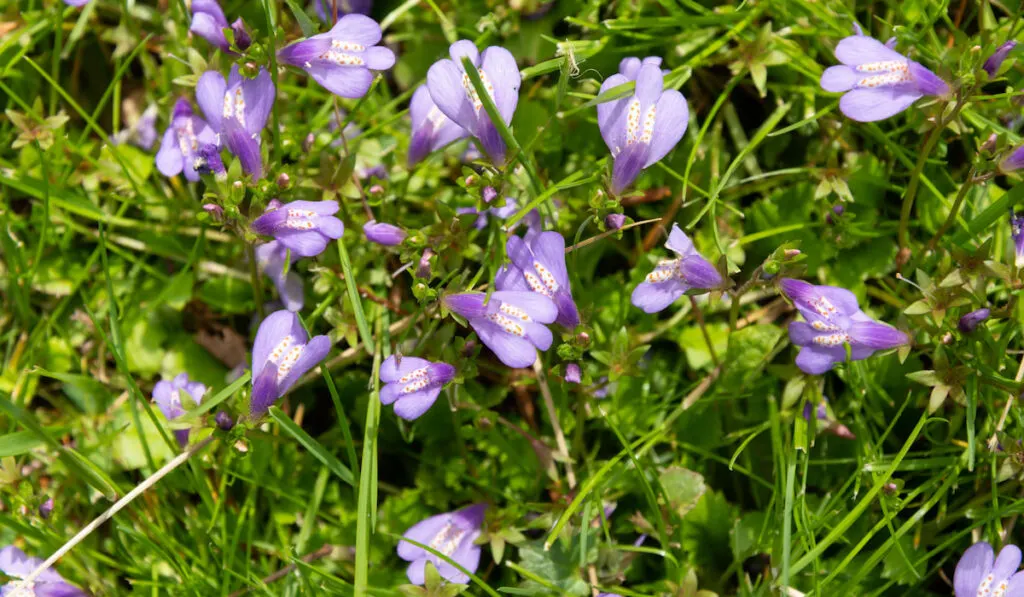
Creeping mazus are indigenous to the Himalayas. These herbaceous perennials grow and spread to form mat-like structures that extensively cover the ground.
Although they only measure 1 to 2 inches, creeping mazus can spread up to 12 inches wide. These plants grow best in hardiness zones 5 to 8.
You can spot creeping mazus by their dense, bright green foliage and tubular lavender or purplish-blue flowers with yellow and white markings on the petals.
They start blooming in the spring and continue until summer.
Unlike some delicate groundcovers, these plants can tolerate foot traffic. Creeping mazus can tolerate partial or full sun and prefer well-drained soil with enough moisture.
15. Cheddar Pink (Dianthus gratianopolitanus)
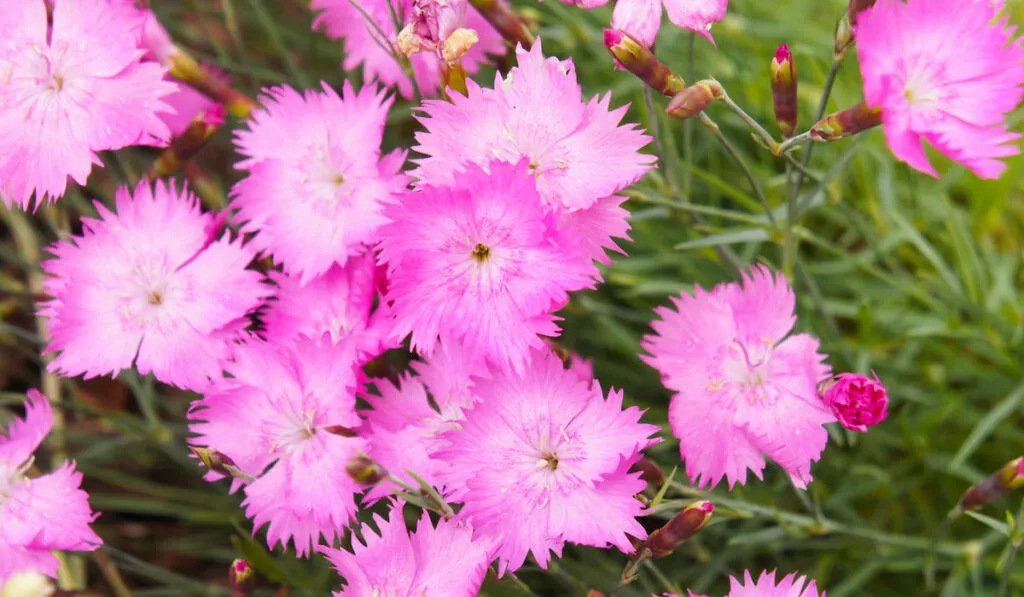
Cheddar pink plants are indigenous to Europe, specifically in Cheddar Gorge, England. This is also where they get their name from.
They are also called sweet pink, clove pink, mountain pink, and cliff pink. These low-growing plants measure 5 to 6 inches tall but can spread up to 1 foot wide.
You can recognize Cheddar pinks by their grayish-green long leaves and vibrant pink flowers.
These flowers produce clove-like fragrances that attract insect pollinators such as butterflies and bees.
Cheddar pinks thrive in hardiness zones 4 to 8. They grow well under full sun and in moist and slightly alkaline soil with proper drainage. They can also tolerate salty soil and a brief period of dry and hot seasons.
Final Thoughts
Aside from elevating the appearance of your garden, ground covers also play an important part in maintaining a sustainable ecosystem. Without groundcovers, your landscape might experience soil erosion.
These plants can also retain more moisture in the soil, thus making it easier for other tall and upright plants to endure extreme dehydration, especially during hot seasons.
Resources
- https://www.goodhousekeeping.com/home/gardening/g32440508/best-ground-cover-plants/
- https://www.thespruce.com/purple-ice-plant-2132553
- https://www.gardeningknowhow.com/ornamental/flowers/ice-plant/growing-hardy-ice-plant.htm
- https://www.thespruce.com/how-to-grow-chamomile-1402627
- https://www.gardenia.net/plant/chamaemelum-nobile
- https://plants.ces.ncsu.edu/plants/pachysandra-terminalis/
- https://www.missouribotanicalgarden.org/PlantFinder/PlantFinderDetails.aspx?kempercode=e430
- https://www.gardenia.net/plant/anemone-canadensis
- https://www.gardenia.net/plant-variety/phlox-subulata-creeping-phlox
- https://gardenerspath.com/plants/flowers/grow-creeping-phlox/
- https://www.thespruce.com/candytuft-flowers-for-your-garden-2132549
- https://www.gardeningknowhow.com/ornamental/flowers/candytuft/growing-candytuft.htm
- https://www.gardenia.net/plant/sedum-spurium-dragons-blood
- https://www.gardeningknowhow.com/ornamental/cacti-succulents/sedum/growing-dragons-blood-sedum.htm
- https://savvygardening.com/sweet-woodruff/
- https://www.thespruce.com/sweet-woodruff-plants-2132332
- https://www.gardenia.net/plant/thymus-serpyllum-creeping-thyme
- https://www.thespruce.com/types-of-creeping-thyme-2132329
- https://www.ediblewildfood.com/wild-violet.aspx
- http://www.newmoonnursery.com/plant/Viola-sororia
- https://www.live-native.com/creeping-dogwood-info-planting-care-tips/
- https://www.finegardening.com/plant/creeping-dogwood-cornus-canadensis
- https://www.bluestoneperennials.com/LIGW.html
- https://www.gardenia.net/plant/lithodora-diffusa-grace-ward
- https://www.gardeningknowhow.com/ornamental/flowers/alyssum/growing-sweet-alyssum.htm
- https://www.thespruce.com/how-to-grow-sweet-alyssum-1402862
- https://www.gardenia.net/plant/dianthus-gratianopolitanus-cheddar-pink
- https://plants.ces.ncsu.edu/plants/dianthus-gratianopolitanus/
- https://www.missouribotanicalgarden.org/PlantFinder/PlantFinderDetails.aspx?taxonid
- https://www.gardenia.net/plant/mazus-reptans
